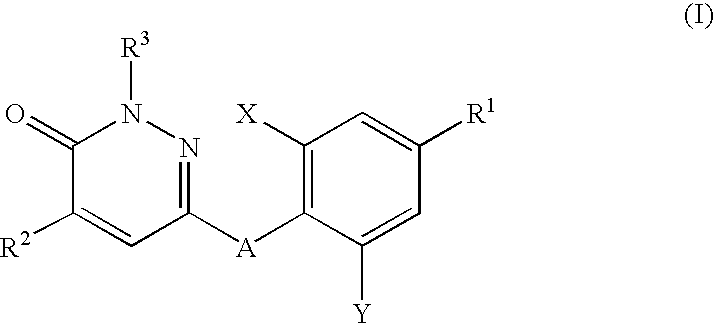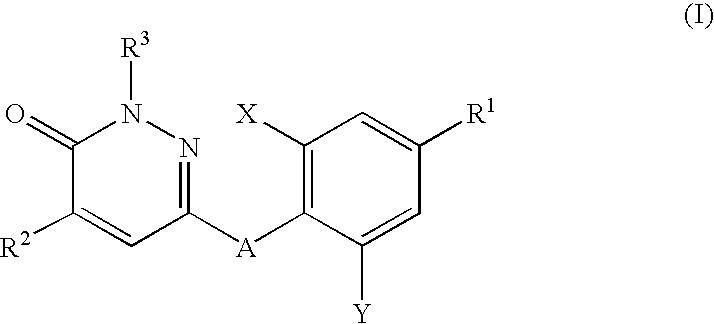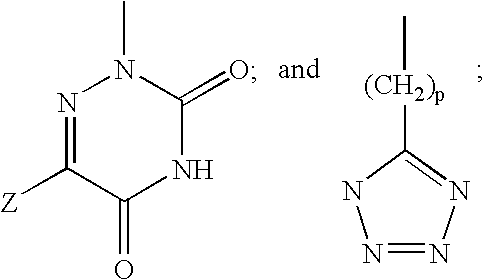Thyroid hormone analogs
a thyroid hormone and analog technology, applied in the field of pyridazinone analogs, can solve the problems of limited therapeutic use of naturally occurring thyroid hormon
- Summary
- Abstract
- Description
- Claims
- Application Information
AI Technical Summary
Problems solved by technology
Method used
Image
Examples
example 1
Synthesis of [4-(5-isopropyl-6-oxo-1,6-dihydro-pyridazin-3-yloxy)-3,5-dimethyl-phenyl]-acetic acid (10a)
[0075]
Step 1: Preparation of 4-dimethylaminomethyl-2,6-dimethyl-phenol (2a)
[0076] A solution of 2,6-dimethyl phenol (20 g, 0.163 mol) in ethanol (100 mL) at room temperature was treated with dimethylamine (19 mL of a 40% solution of dimethylamine in water, 0.163 mol) followed by formaldehyde (13.5 mL of a 37% solution of formaldehyde in water, 0.163 mol). The reaction was heated to reflux for 12 h. The reaction mixture was cooled to 0° C. in an ice bath, diluted with water (100 mL) and brought to pH=5 with a 1N aqueous hydrochloric acid solution. The water layer was extracted with diethyl ether (2×150 mL). The aqueous layer was brought to pH=8 by the addition of a 1N aqueous sodium hydroxide solution, cooled to 0° C. in an ice bath and was extracted with diethyl ether (3×200 mL). The organics were washed with a saturated aqueous sodium chloride solution, dried with magnesium sul...
example 2
Preparation of [3-Chloro-4-(5-isopropyl-6-oxo-1,6-dihydro-pyridazin-3-yloxy)-5-methyl-phenyl]-acetic acid (10b)
[0085]
Step 1: Preparation of 2-Chloro-4-dimethylaminomethyl-6-methyl-phenol (2b)
[0086] A solution of 2-chloro-6-methyl phenol (5.0 g, 0.035 mol) in ethanol (25 mL) at room temperature was treated with dimethyl amine (3.95 mL of a 40% solution of dimethylamine in water, 0.035 mol) followed by formaldehyde (2.85 mL of a 37% solution of formaldehyde in water, 0.035 mol). The reaction was heated to reflux for 24 h. At this time, the reaction mixture was cooled to room temperature and concentrated under vacuum. The resulting oil was diluted with water (200 mL) and acidified to pH=2 by addition of a 1N aqueous hydrochloric acid solution. The water layer was extracted with ethyl acetate (300 mL). The ethyl acetate layer was discarded. The water layer was made basic to pH=10 by the addition of a 1N aqueous sodium hydroxide solution and was extracted with ethyl acetate (2×350 mL)....
example 3
Synthesis of [3,5-Dibromo-4-(5-isopropyl-6-oxo-1,6-dihydro-pyridazin-3-yloxy)-phenyl]-acetic acid (14)
[0094]
Step 1: Preparation of 2,6-Dibromo-4-(2-hydroxy-ethyl)-phenol (11)
[0095] A solution of 4-(2-hydroxy-ethyl)-phenol (50 g, 0.35 mol) in glacial acetic acid (400 mL) was treated with a solution of bromine (41 mL, 0.78 mol) in glacial acetic acid (40 mL). The reaction mixture was stirred at room temperature overnight. At this time, the solvent was removed under vacuum. The resulting residue was diluted with toluene (200 mL) and the solvent was again concentrated under vacuum. The resulting residue was dissolved in tetrahydrofuran (250 mL) and a 4N aqueous sodium hydroxide solution (350 mL) was added followed by water (150 mL). The reaction was stirred at room temperature for 3 h. The reaction was then brought to pH=5 by the addition of concentrated hydrochloric acid (80 mL). The layers were separated (the bottom layer is product). The aqueous layer was extracted with methyl tert...
PUM
| Property | Measurement | Unit |
|---|---|---|
| temperature | aaaaa | aaaaa |
| temperature | aaaaa | aaaaa |
| temperature | aaaaa | aaaaa |
Abstract
Description
Claims
Application Information
 Login to View More
Login to View More - R&D
- Intellectual Property
- Life Sciences
- Materials
- Tech Scout
- Unparalleled Data Quality
- Higher Quality Content
- 60% Fewer Hallucinations
Browse by: Latest US Patents, China's latest patents, Technical Efficacy Thesaurus, Application Domain, Technology Topic, Popular Technical Reports.
© 2025 PatSnap. All rights reserved.Legal|Privacy policy|Modern Slavery Act Transparency Statement|Sitemap|About US| Contact US: help@patsnap.com



